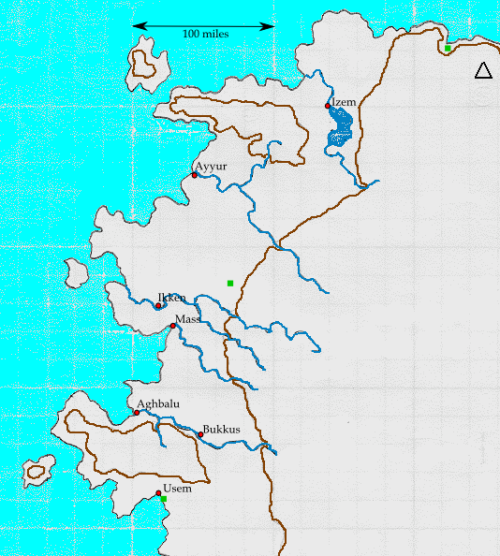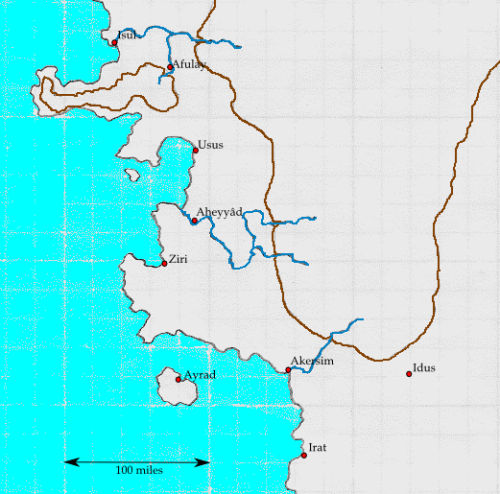Mosaî, "The Hidden Empire"
Note: This is the location for the "V3" campaign.
Mosaî (pronounced “MOS aye” or “MOS ah ee”) is located on the western shore of Thentao (north and west of the "Sea of Sand") and consists of the remnants of the Arral Empire – which was destroyed at the end of the second age. Due to its remote location (and the desire of its inhabitants to remain secluded), it is oftentimes referred to as “The Hidden Empire”.
History
In the second age, the mighty Arral Empire occupied these lands (as well as most of what is now known as the "Sea of Sand"). With the climate shift at the end of the second age, the amount of arable land dramatically shrank, forcing the peoples to migrate to the cooler coastal region. The resulting overcrowding led to deprivation and conflict. Within twenty years, all of the old societal structure had collapsed – replaced by brutal tribal warfare.
Beginning in the year III:75, the Massin tribe began a bloody campaign of conquest against the remaining tribes. Over the course of the next 90 years, they gradually gained control of the entire region, forming the first unified government in III:164. Despite their history of brutality, the Massinians evolved into an effective and relatively stable ruling class and their descendants ruled in one form or another for seven centuries.
In the year III:870, a large force of Goblins and Giants invaded – leading to an 88-year period of brutal occupation. The human population was finally able to shake off their Goblin overlords in III:958, after a careful and methodical 30-year revolution.
Without the goblin enemy to unite the historically divisive tribes, the rebel leaders feared their new freedom would not last. To remedy this, they formed the Amalu council – a religious order which maintains a loose confederacy between the sixteen city-states.
Recent Events
Since most governments in Mosaî are theocracies, the most significant event in recent history was the shift from the Sumerian gods to the "New Gods" in the year 1104 (see the “Religion” section below).
As soon as the ripples from that event began to subside, the magic change in 1108 occurred. As the arcanists in the region relied heavily on elemental magic, this change affected society more deeply than in other regions of the world.
Then, within a year of the magic change, a third disruption occurred when a man named Kevin Arcana arrived and announced the existence of a magical portal near the city of Usem that linked to various points around the rest of the world. Prior to this, Mosaî was very isolated from the rest of the world. A second portal exists northeast of the twin cities of Mass and Ikken, but its remote location makes it less useful.
In the few years since, a series of “trade routes” have sprung up – linking the local merchants with those in Spindrift, Rota, Blanan, The City of Edric, Arela, and the Wall Islands. This infusion of outside culture has both stimulated and alarmed society. A small minority of conservative dissidents (known as the “Aksim”) have taken to armed revolt against what they see as a pollution of their culture, but the majority either recognize the influence as inevitabile or don't see it as a problem.
It is currently the year 1119.1) It's been a full decade since the introduction of the portals – so trade routes to the outside are well established. In addition, a steady trickle of immigrants has infused the area with many varied cultural influences.2)
Religion
The primary pantheon worshiped here is the Sumerian gods. With their destruction in III:1104 by the Godslayer, the priests found their power had vanished. For 84 days, no major spells functioned and panic gripped the populace. This period is known among the priests as the “gap”.
After 84 days of silence, the gods suddenly reappeared – but each one claimed to have a new name. There are many among the clergy who believe these “post- gap” gods are, in fact, "new gods" – though most preach the “new name” theory so as not to alarm the general public.
In the years since the “gap”, a growing rebellion against the church has emerged. Without access to divine spells, this group has not been very effective in opposing the new gods, but in the last few years, they have become more insistent (and more violent).
Regions
Mosaî is divided into two main regions: North and South. The Southern Mosaî people cling more closely to their ancient roots, revering the ancient gods and proud of their links to the mighty Arral Empire. Their architecture uses more stone and includes elegant spires, many with Onion domes.
The Northern Mosaî people, on the other hand, use primarily wood construction and consider themselves to be more connected to the future than the past. They eschew the ancient traditions and have developed an affinity for magics linked to nature.
Geographically, there is little difference between the two regions, though the north has a higher rainfall. There are eight “major” rivers: Anir, Ugwistan, Asafar, Ilayetmas, Sifaks, Anazâr, Takfarinas, Meddur (in order from South to North).
A more important division is that between the various tribes (or clans). Despite centuries of civilization, alliances or feuds between the houses often times mean more to the people than regional, political, or even religious differences.
| City-States in Mosaî (in order from South to North) | |||
|---|---|---|---|
| Name | “Lawfulness”3) | Power Level | Notes |
| Irat | 72 | 85 | Consider themselves the defenders of Mosaî |
| Ayrad | 56 | 84 | Island people; Fishermen; Very insular |
| Idus | 24 | 40 | The “frontier”; Interacts with the Fadil frequently |
| Akersim | 98 | 48 | Arrogant, but relatively peaceful |
| Ziri | 57 | 84 | Militaristic, but insular |
| Aheyyâd | 44 | 47 | Boring |
| Usus | 22 | 63 | Shipbuilders; Pirates |
| Afulay | 52 | 88 | Miners |
| Isul | 99 | 38 | Consider themselves to be the rulers of Mosaî |
| Usem | 31 | 26 | The portal city; Thriving trade has been unable to lift this city from its poverty. |
| Bukkus | 28 | 19 | Very poor |
| Aghbalu | 31 | 58 | Together with Usem and Bukkus, often called the “border cities” (border between North and South) |
| Mass | 40 | 93 | The most powerful military and economy in Mosaî |
| Ikken | 13 | 61 | Has been occupied by Mass since the Giant wars |
| Ayyur | 91 | 15 | Philosophical and learned people; Premiere libraries and research institutions |
| Izem | 3 | 28 | “The Lake People”; “The other frontier”; Integrated with Orc/Goblin tribes |
Outside Threats
The primary threat to Mosaî comes from the border mountains – where numerous tribes of Goblins, Orcs, and Giants live. Interspersed throughout are other fell humanoids such as Bugbears, Ogres, Gnolls, and the like.
While the Goblins and Orcs represent the most organized threats, they are weak in numbers compared to the humans – and also have to contend with threats from the other humanoid races in the mountains.
The Giants, of course, are fewer even than the Goblins – but they have sufficient strength to be the most formidable foe. Case in point: when children are disciplined in Mosaî, they are told that the “Giants” will come get them, not that the “Goblins” will come get them.
Magic
Traditional spell magic (both Arcane and Divine) is the most common form of magic practiced in Mosaî. Prior to 1108, many spellcasters used an ancient form of spell magic that relied heavily on the elements. As a result of the Shadowlord's takeover, many of those magicians lost their powers and had to either give up or retrain. Despite this, however, elemental magic still has a major influence on this region.
A small minority of magicians in Mosaî use either Voice Magic (as practiced primarily by the Fadil tribes in the Sea of Sand) or Rune Magic (as practiced by the secretive kingdom of Dumaka).


